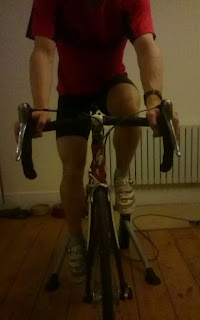I was asked by James Haigh, an Exeter Tri Club member and Team Reko athlete, to do a bike fit for him. He's had a tough time of things with injuries this year that haven't been his fault, so he's keen to hit next season at full tilt.
He'd identified, correctly, the importance of getting a good bike fit for: injury prevention and management; efficiency; comfort; and power. Particularly over the winter months James will be riding his road bike and getting some long rides outside as well as specific indoor sessions on his Wattbike under the direction of his coach and former pro-triathlete Jo Carritt, so he first of all wanted his road bike set up as well as possible.
Like many athletes James is quite aware of his body and sensitive to small changes and tweaks. He'd recently been suffering from a bit of Achilles tendinopathy on one side and an intermittent twinge in the back of the other knee. I'd managed to help him through the Achilles problem with some focussed rehab so he could gradually reintroduce running into his schedule, but we wanted to look a bit more closely at his bike set up as the knee symptoms were a new thing that seemed to be related more to cycling.
As I knew quite a bit about James beforehand, including his injury profile, I didn't need to cover that again. So, setting him up on the turbo trainer a few things were readily apparent: at normal speed with the naked eye it looked like he was both over-reaching with his feet and his arms; his toes pointing down too much (plantar flexing), knees extending, and arms straight despite not even reaching the hoods.
The next stage was to analyse it in a bit more detail and look at some finer points and measurements like specific knee, hip, and elbow angles, position of the knee in relation to the toes, head position, lateral movement of the knees, and a few other things. In order to do this I took some video footage which I then reviewed in slow motion, from the front, back and side. This allowed me to see natural, real-time movements with a more accurate and critical eye, picking up smaller changes than otherwise possible.
 |
| Fine seat adjustments allowed us to achieve ideal knee range. |
I was then in a position to take some measurements. For this, I eschewed the traditional method of a goniometer (essentially a large, long-handled protractor) and used some image software to measure joint angles over the images I had taken. This allowed me to more accurately aim to reproduce the known optimal joint angles for power production in cycling. It didn't take major adjustments to the seat, but small changes in both seat height and fore/aft position improved the knee range from just "OK" to "ideal".
Next we needed to address the hand/arm position. As mentioned earlier, James needed to really over-reach to get onto his hoods, thus extending his elbows excessively, closing down his hip angle too much, and also having to crane his neck quite a bit. As we were already at the limit of seat adjustability, we had to look at the "cockpit" of the bike to address this further. One option would be to change components, but rather than recommending he go out and spend a lump of money on buying a shorter stem, we instead adjusted the position of his handlebars and the hoods quite significantly. This not only allowed him to sit comfortably on the hoods, but also gave him improved access to ride on the drops too, whilst maintaining good body/limb/head position.
 |
| Making sure we don't have too much hip flexion, which can be both inefficient and uncomfortable. |
The final thing that I noticed was a slight outward "kick" of the knee. If you look at cyclists from behind you'll often see this as quite a noticeable habit, often unilaterally (one side only). In James it was very subtle but, given the purpose of the fit, I wanted to address it as best possible. This required a very small adjustment to his cleat rotation which immediately evened things out.
 |
| Anterior view allows us to look for unwanted lateral knee movements and might indicate a need to adjust the cleats. |
James took his first test ride at the weekend and sent me the following message:
"The bike ride on Saturday felt a lot more comfortable. I think the hood position change is the most significant (both in amount moved and the difference it makes), but the other tweaks seemed to have had positive effects, too.
I didn't have as much calf pain on getting off the bike and, even though I had gone 70km and was feeling pretty drained from the week not sleeping well and the swim that morning, I didn't feel really taxed afterwards. Thanks very much for what seems like a very successful fitting - I don't think I'll be needing to come back to have anything changed, but I'll give it another ride or so, to see if I still feel as good as I did after the ride just gone."
I was very pleased to get this feedback and look forward to setting James up on his TT bike, where he is keen to try a more aggressive position for racing. It's great to be able to have a positive impact on people, whether it's through physiotherapy, coaching, a bike fit, or something else entirely.
Remember, you shouldn't fit the bike: the bike should fit you!
